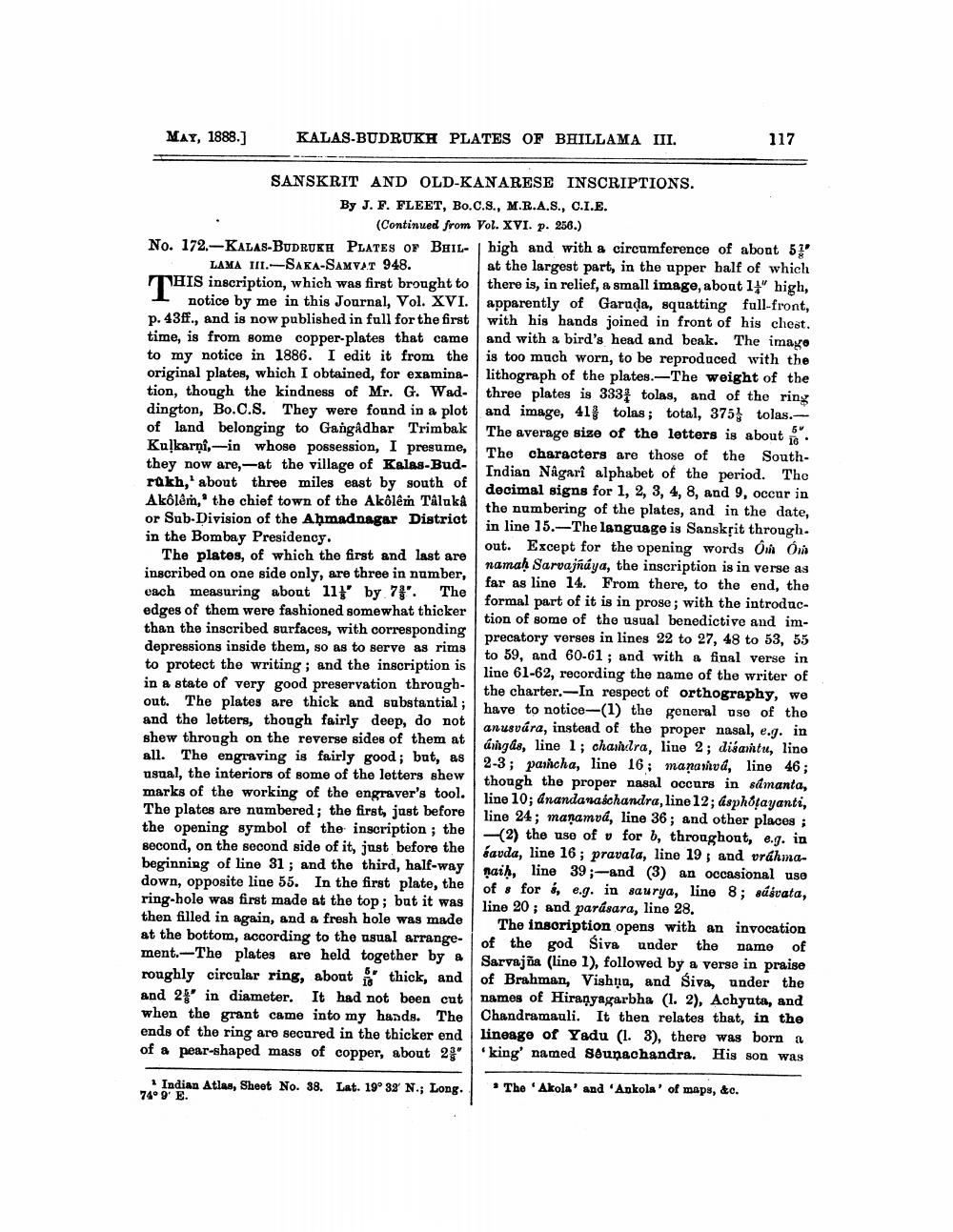________________
MAY, 1888.]
KALAS-BUDRUKH PLATES OF BHILLAMA III.
117
SANSKRIT AND OLD-KANARESE INSCRIPTIONS.
By J. F. FLEET, Bo.C.S., M.R.A.S., C.I.E.
(Continued from Vol. XVI. p. 256.) No. 172.-KALAS-BUDRUKU PLATES OF BHIL- high and with a circumference of about 5]" LAMA III.-SAKA-SAMVAT 948.
at the largest part, in the upper balf of which THIS inscription, which was first brought to there is, in relief, a small image, about 1high,
I notice by me in this Journal, Vol. XVI. apparently of Garuda, squatting full-front, p. 43ff., and is now published in full for the first with his hands joined in front of his chest. time, is from some copper-plates that came and with a bird's head and beak. The imago to my notice in 1886. I edit it from the is too much worn, to be reproduced with the original plates, which I obtained, for examina- lithograph of the plates.-The weight of the tion, though the kindness of Mr. G. Wad. three plates is 3331 tolas, and of the ring dington, Bo.C.S. They were found in a plot and image, 41% tolas; total, 375) tolas. of land belonging to Gangadhar Trimbak The average size of the letters is about a Kuļkarni,-in whose possession, I presume,
The characters are those of the Souththey now are,-at the village of Kalas-Bud.
Indian Nagari alphabet of the period. The rakh,' about three miles east by south of
decimal signs for 1, 2, 3, 4, 8, and 9, occur in Akôlêń, the chief town of the Akôlêr Taluka
the numbering of the plates, and in the date, or Sub-Division of the Ahmadnagar Distriot
in line 15.-The language is Sanskrit through. in the Bombay Presidency.
out. Except for the opening words On Ó The platos, of which the first and last are
namah Sarvajñáya, the inscription is in verse as inscribed on one side only, are three in number,
far as line 14. From there, to the end, the each measuring about 113' by 7f". The
formal part of it is in prose; with the introducedges of them were fashioned somewhat thicker
tion of some of the usual benedictive and imthan the inscribed surfaces, with corresponding
precatory verses in lines 22 to 27, 48 to 53, 55 depressions inside them, so as to serve as rims
to 59, and 60-61 ; and with a final verse in to protect the writing; and the inscription is
line 61-62, recording the name of the writer of in a state of very good preservation through
the charter.-In respect of orthography, we out. The plates are thick and substantial;
have to notice-(1) the general use of the and the letters, though fairly deep, do not
anusvára, instead of the proper nasal, e.g. in shew through on the reverse sides of them at
árngas, line 1; charnelra, line 2; disantu, line all. The engraving is fairly good; but, as
| 2-3; pashcha, line 16; mananvá, line 46; usual, the interiors of some of the letters shew
though the proper nasal occurs in samanta, marks of the working of the engraver's tool. line 10; Anandanaśchandra, line 12; asphôțayanti,
The plates are numbered; the first, just before line 24; manamvá, line 36; and other places ; the opening symbol of the inscription; the -(2) the use of v for b, throughout, e.g. in second, on the second side of it, just before the savda, line 16; pravala, line 19, and vráhmabeginning of line 31 ; and the third, half-way naih, line 39; -and (3) an occasional use down, opposite line 55. In the first plate, the of 3 for á, e.g. in saurya, line 8; sásvata, ring-hole was first made at the top; but it was line 20 ; and parásara, line 28. then filled in again, and a fresh hole was made
The insoription opens with an invocation at the bottom, according to the usual arrange- of the god Śiva under the name of ment. The plates are held together by # Sarvajña (line 1), followed by a verse in praise roughly circular ring, about thick, and of Brahman, Vishna, and Siva, under the and 2 in diameter. It had not been cut names of Hiranyagarbha (1. 2), Achyuta, and when the grant came into my hands. The Chandramauli. It then relates that, in the ends of the ring are secured in the thicker end lineage of Yadu (1.3), there was born a of a pear-shaped mass of copper, about 2 'king' named Sounachandra. His son was
Indian Atlas, Sheet No. 38. Lat. 19° 32' N.; Long. 74° 9' E.
• The 'Akola' and 'Ankola' of maps, &c.




